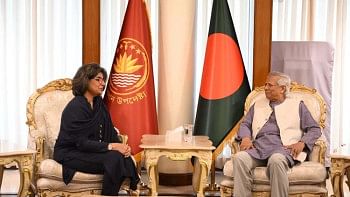Critical water issues in Bangladesh
One issue that is rarely focused upon by planners is the huge demand for water and the associated energy demand as industrial activity expands and the country develops. We often hear of energy crisis, food crisis but rarely of water crisis. That a huge water shortage is looming in the horizon has hardly been considered in national plans. Energy and water are essential ingredients for economic development and food production. According to the United Nations, by 2030 the world will need at least 30% more water, 45% more energy, and 50% more food. To meet the challenges of water shortage and supply large quantities of energy would be required.
Groundwater extraction both for municipal water supply and irrigation has reached alarming proportions in some places. Industries also depend on groundwater. Every year groundwater level is falling in areas of excessive extraction. If the trend continues severe shortages will be felt in those places. Other than a few urban centres water supply of all municipalities is dependent on groundwater. Surface water is often advocated as the cheapest and easiest solution, but this free resource in most areas surrounding large urban and industrial centres is either not usable or no longer available. The extremely poor quality of the water as a result of industrial effluent discharge and other human activities makes its use nearly impossible.
Already Saidabad is facing problems with the quality of the intake water. The cost of water treatment is escalating because the purification steps, which require a lot of energy, for bad quality water keep on increasing. If extreme techniques like reverse osmosis or desalination have to be used to get usable water then water becomes equivalent to energy. Energy is required for extracting, treating and supplying water.
If water has to be conveyed long distances through rough terrain it becomes an energy intensive process and the supplied water thus becomes very expensive. In California, the State Water Project (SWP) pumps water almost 2,000 ft over the Tehachapi Mountains. The SWP is the largest single user of energy in California. It consumes an average of 5 billion kWh/yr, accounting for about 2% to 3% of electricity consumed in California.
The connection between water and energy is straightforward. Energy (electricity and diesel) is required to pump water. In the irrigation season during January to April nearly 1,500 MW need to be devoted to this activity, and load-shedding is aggravated by this seasonal demand. To serve an annual average load of 7,500 MW, approximately 9,000 MW of capacity would need to be maintained. It is expensive to maintain such a large capacity for seasonal use only.
Shallow and deep tubewells consume nearly 5% of the total electricity. Industrial and other private groundwater extraction also consume a lot of electricity. If the power for water pumping for municipal supply and the thousands of small pumps needed to lift water from ground-level reservoirs to overhead tanks in houses, commercial buildings and industrial establishments are included then another 5% must be added. Irrigation pumps also consume more than half a million tons of diesel. Electricity is also expended to convey and treat wastewater. Therefore, it would be safe to conclude that nearly 10% of the total primary energy is required for water.
Groundwater recharge is limited to only the monsoon months. Since recharge is a slow process most of the rainwater drains away. In the future, highly energy intensive mechanical recharge using giant pumps of underground aquifers may be required to ensure enough water for irrigation and other purposes during the dry season. This would more than double the energy requirement for irrigation.
At the time of independence in 1971, the main rice crop was rain-fed Aman. In 40 years that has shifted to Boro, which requires irrigation. The easy availability of diesel and electricity in rural areas prompted farmers to irrigate their lands and expand the Boro crop. The marketing of low cost pumping equipment and ready availability of contractors to install deep tubewells allowed farmers to quickly adopt Boro and abandon the risk-prone Aman.
The dry season water availability has been aggravated by climate change and the unilateral withdrawal of river water by India. The dry season in Bangladesh is getting longer due to the effects of climate change. Increase in temperature due to global warming, especially during the water shortage months, is causing ponds to dry up, and increased evaporation and transpiration losses mean that more than usual water has to be supplied to sustain agriculture.
Despite being an upper riparian country India is constructing dams on rivers that flow into Bangladesh and diverting water for irrigation projects. As a lower riparian country Bangladesh has the full right to demand water.
The following water management measures can be employed to reduce water use:
(i) Conservation and efficient use of water in all sectors,
(ii) Excavation of ponds, protection of wetlands and promotion of rainwater harvesting,
(iii) Shifting of a portion of the irrigated Boro to rain-fed Aman; practicing improved irrigation techniques that require less water
There are numerous water saving measures that can be practiced even at the household level, such as high-velocity low-flow showerheads, dual-flush toilets, sensor activated faucets and 'gray' water recycling. Of course all these will involve considerable upfront capital expense, but on a life cycle basis water and energy savings will more than pay back that expenditure. Rainwater harvesting is now considered as a major water management technique, and should be aggressively promoted, especially in the industrial sector. Shifting from Boro to Aman could be achieved if crop insurance is initiated. Many advanced irrigation techniques that require less water than conventional irrigation have been developed in drought prone countries.
The writer is Professor, Chemical Engineering Department , BUET.

 For all latest news, follow The Daily Star's Google News channel.
For all latest news, follow The Daily Star's Google News channel. 



Comments